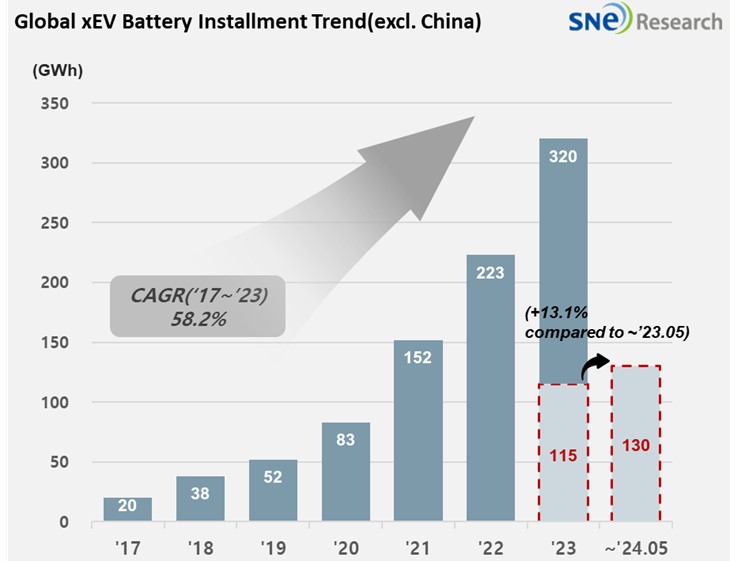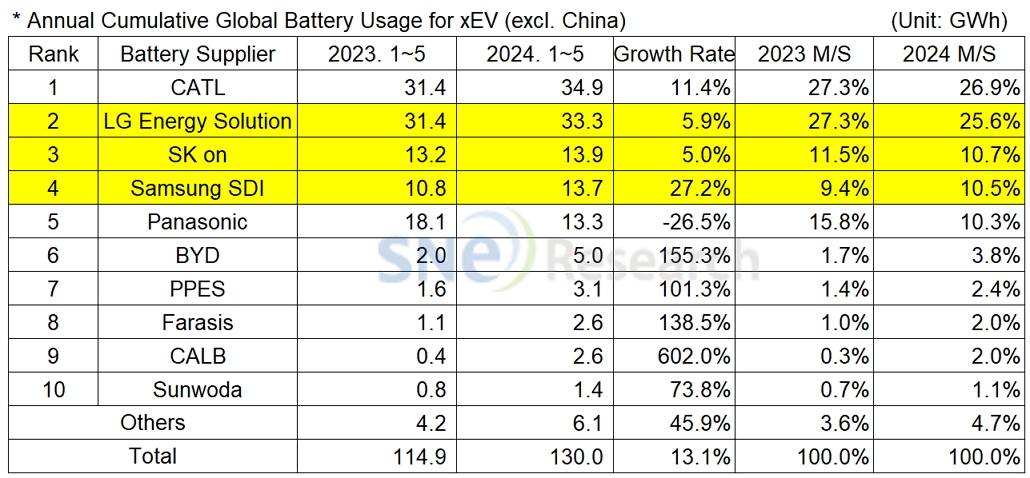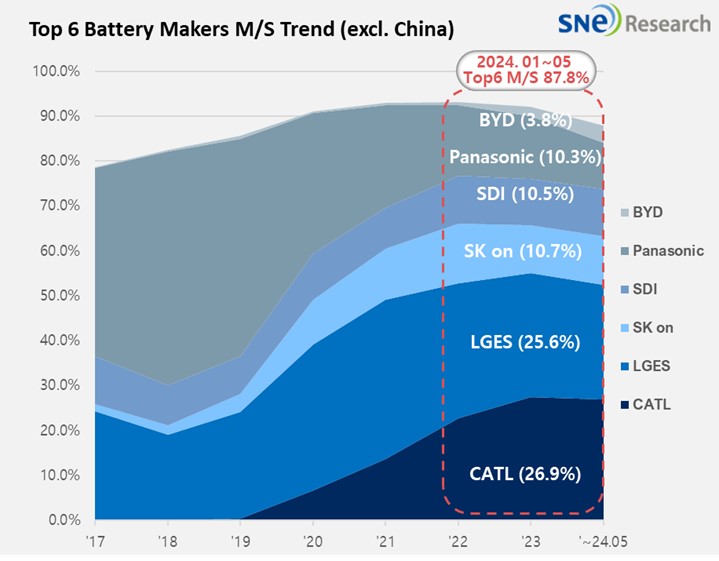From Jan to May 2024, Non-Chinese Global[1] EV Battery Usage[2] Posted 130.0GWh, a 13.1% YoY Growth
- K-trio’s combined M/S recorded 46.8% from Jan to May 2024
Battery installation for
global electric vehicles (EV, PHEV, HEV) excluding the Chinese market sold from
January to May in 2024 was approx. was 130.0GWh, a 13.1% YoY growth.

(Source: Global EV and Battery Monthly Tracker – June 2024, SNE Research)
In the ranking of battery usage for electric vehicles, the K-trio battery makers all ranked within the top 5. LG Energy Solution captured the 2nd place with a 5.9%(33.3GWh) YoY growth. Samsung SDI posted the highest growth of 27.2%(13.7GWh) among the K-trio battery makers. With SK On exhibiting a growth of 5.0%(13.9GWh), the K-trio were all in an upward trajectory.

(Source: Global EV and Battery Monthly Tracker – June 2024, SNE Research)
The combined shares of K-trio recorded 46.8%, a 1.4%p YoY decline. If we look at the usage of K-trio battery in line with the sales volume of electric vehicles, Samsung SDI’s strong growth was led by favorable sales of BMW i4/5/X, Audi Q8 e-Tron, and FIAT 500 electric in Europe and the sale of Rivian R1T/R1S in North America. Samsung SDI, targeting the premium electric vehicle battery market both for BEV and PHEV, said that it would expect to see a significant improvement in profit in the entire electric vehicle group from Q2 this year based on its high-value-added battery P5 and P6.
Despite a YoY decline in sales of Hyundai IONIQ 5 and EV 6, SK On registered a growth thanks to solid sales of Ford F-150 and Mercedes EQA/B to which SK On’s battery is installed. SK On is scheduled to retool its Ford-dedicated battery production line at Plant 2 in the state of George for Hyundai within this year and to start operating the Plant 3 in Hungary with 30GWh capacity. Through these efforts, SK On aims to turning into profit making in the latter half of this year.
LG Energy Solution continued to be in an upward trajectory thanks to favorable sales of local OEMs in North America such as Ford Mustang Mach-E and GM LYRIQ as well as those of Tesla Model 3/Y and Renault Megane in Europe. Recently, new models to which batteries, produced by the joint ventures between LG Energy Solution and global OEMs, are installed, have released in the market. KIA’s compact SUV EV3 was officially launched with NCMA battery cell, manufactured by HLI Green Power – an Indonesia joint venture between LGES and Hyundai Motor Group, installed inside. In addition, KIA’s sedan EV4, slated for launching next year, is expected to have the battery produced by HLI Green Power inside. GM’s Cadillac LYRIQ, released in the Korean market last month, also has NCMA battery cell by Ultium Cells, a joint venture between LGES and GM. With a large 102kWh battery installed, Cadillac LYRIQ can drive up to 465km on a full charge. As the 2nd Ultium Cells plant is planned to increase its production and a new model on the Ultium platform is set to hit stores, LG Energy Solution is forecasted to lead the battery sector in the North American market with its ternary battery, satisfying the IRA regulations.
Panasonic recorded 13.3GWh from Jan to May this year in the non-China global market, posting a 26.5% YoY degrowth. Major reasons for Panasonic’s degrowth were a slowdown in sales of Tesla Model 3 due to its partial change and the delayed release of Model 3 Performance trim to which Panasonic’s battery is installed. Currently, it is highly likely that Tesla would use Panasonic’s battery for specific trims to benefit from the US IRA regulations, leading to an expectation for possible changes in shares held by battery suppliers in future. On the other hand, Panasonic made an announcement last June that it would turn to both North America and Japan rather than focusing on North America only as Panasonic lowered its forecast on the 2030 EV penetration rate from 50% to 30% in North America.
CATL, rapidly expanding its market share even in the non-China market, captured the top position with a 11.4%(34.9GWh) YoY growth. CATL’s battery is installed to Tesla Model 3/Y (made in China and exported to Europe, North America, and Asia) and vehicle models made by other major OEMs such as BMW, MG, Mercedes, and Volvo. In addition, CATL’s battery is installed to KONA and NIRO by Hyujndai and Ray EV by KIA, meaning that the influence from those Chinese companies has been increasing not only on the global stage but also in the Korean domestic market. Similar to CATL, BYD is threatening other players in the market, continuing to be in high growth in the non-China market. The oversupply issue in the Chinese domestic market is addressed by exporting to overseas markets such as Brazil, Thailand, Israel, and Australia, indicating that the Chinese makers have been expanding their global market shares at a rapid pace.

(Source: Global EV and Battery Monthly Tracker – June 2024, SNE Research)
Compared to China keeping a high growth of economy by promoting the large-scale renewal of equipment and trade-ins of consumer goods, the US has recorded a growth rate lower than expected despite the implementation of IRA. In Europe, the EV market has been hitting speed bumps with reductions in EV subsidies and relaxation of carbon emission regulations. In particular, the K-trio seemed to hit hard by such slowdown in the US, where they hold large market shares, rather than in Europe where competitions with the Chinese counterparts are fierce. As Panasonic, a major supplier to Tesla decided to take a two-pillar strategy (which, however, needs to be closely monitored whether it could act as a positive factor for the K-trio because it is based on a premise that the North American market would experience a possible slowdown); Europe started to intensively prevent the Chinese companies from prospering in the region; and the K-trio plan to ramp up in Europe and North America, it is expected that the EV market other than China would also rebound in the long run with the K-trio’s market shares consequently increasing.
[2] Based on battery installation for xEV registered during the relevant period.

